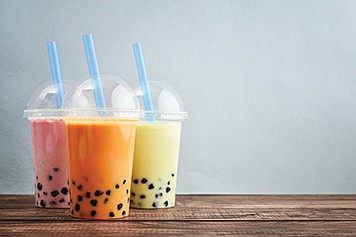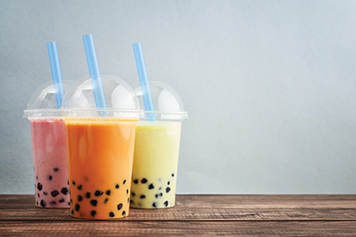Originating in Taiwan in the 1980s, bubble tea, aka boba, is nothing new. But the tea-based drink filled with chewy tapioca balls hasn't taken off in Chattanooga like it has in places such as Tokyo or larger U.S. cities such as San Francisco and New York - until now.
Several boba-focused businesses have opened up locally in the past year, including Kung Fu Tea on the North Shore and Taichi Bubble Tea, which opened its first location in East Brainerd in December 2018 followed by a second downtown this past June. "When we first opened, not many people came for tea," says James Weng, manager of Taichi's downtown location, which also offers ramen and poke bowls. "A lot of people didn't know what bubble tea was."
Several area restaurants, such as The Camp House on M.L. King Boulevard and Chopstix on Lee Highway, previously served the drink to those in the know. It's been popular since the '90s in the U.S. in areas with large Asian populations, but the photogenic drink's popularity has experienced a worldwide resurgence with social media, particularly in college towns and among the 18- to 35-year-old set, according to multiple sources. Yes, boba is having a moment - the worldwide boba market, valued around $2 million in 2016, is expected to rise to $3.2 billion by 2023, according to an Allied Market Research report.
Boba recipes include some type of tea (Taichi offers Assam, green or black), along with condensed or fresh milk or non-dairy milk powder, sugar and marble-size tapioca "bubbles," Weng explains, adding that the amount of sugar can be adjusted according to the customer's preference. Some new boba drinkers are hesitant to eat the bubbles, Weng says, but come to love their sweet flavor and chewy texture once they try them.
Weng recommends Taichi's Thai Original Milk Tea for first-time boba drinkers. Other popular flavors include Taro Milk Tea made with taro root, and Mango Milk Tea.
Bubble vs. Boba
While the two terms are used interchangeably, and both are relevant, they do not mean the same thing.Boba tea does not have a concrete origination story, but according to Bubble Tea Supply, which bills itself as “the first U.S. company to offer bubble tea products online,” what we now know as bubble tea is loosely descended from a popular Taiwanese after-school pastime. “Elementary school children would look forward to buying a cup of refreshing tea after a long, hard day of work and play,” the site says. “Tea stands were set up in front of the schools and would compete for business with the best selling tea.”One clever stand operator started adding fruit flavoring, cementing hers as the most popular and setting the stage for boba’s popularity. To mix the tea and fruit flavoring, the drink needed to be shaken, which formed bubbles, thus the drink came to be known as “bubble tea.” This term still applies to the froth when today’s milk version is shaken to mix, according to New York-based business news publication Quartz.However, the tapioca balls introduced to cold, infused tea in mid-80s Taiwan also resemble bubbles, leading many to believe the moniker references those pearl-like balls. “Boba” is actually Taiwanese slang for those balls, Quartz goes on to state.

